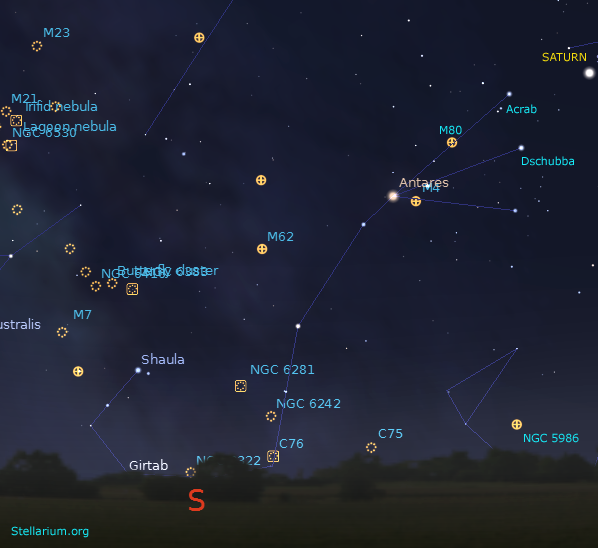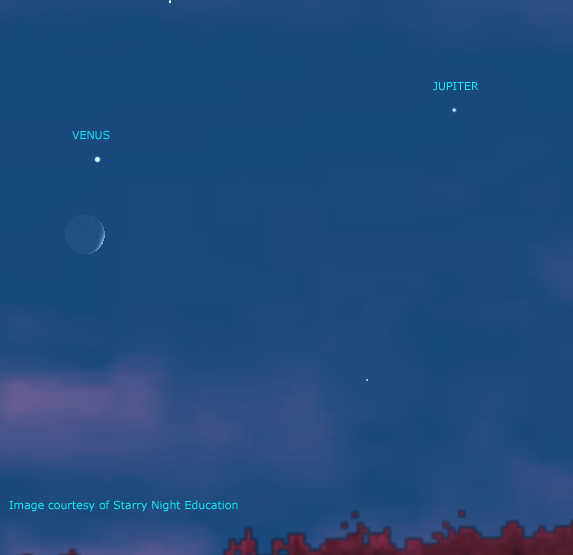Scorpius and The Planet Saturn
The constellation Scorpius is a classic summertime pattern in the southern sky. This month it is well above the horizon when the sky is dark. A perfect silhouette of a scorpion is witnessed by its claws and the reddish star Antares; however, we lose part of its tail from our latitude. But all is not lost as the pair of stinger stars finds its way above the horizon. As mentioned the jewel is Antares aka the heart of the Scorpion. This red supergiant star which is now as wide as the orbit of Jupiter is on its last legs as it chews up its remaining fuel to stay alive.
The higher temperatures fusing elements is trying to keep the outer shell from collapsing onto itself. However, as this process continues the end might appear tonight or hundreds of thousands of years from now. Antares will fuse its last stages and develop an iron core. The layer of cinders from the previous fusions stages will eventually collapse then rebound off the iron core thus resulting in a supernova explosion. At a distance of 553 light-years, we are at a safe distance from this future cosmic light show.

Some of the suns that make up the Scorpion’s claws are double stars along with Antares. From the top of the claws we have Acrab, Dschubba and Pi Scorpii is an eclipsing binary and let’s not forget Al Niyat to the west of Antares. Other than a giant star in destruct mode and a few double and variable stars, we have an array of globular clusters. To date, 157 globular clusters live in the halo of our Milky Way Galaxy of which a good number are found in Scorpius. These balls of distant suns can contain hundreds of thousands to (in some cases) a million stars like the famous M13 found in the constellation Hercules.
Starting from Antares, move your scope 1.3 degrees west until you find M4 at magnitude 5.8. Measured to be 26 arc minutes, this cluster is almost as large of the full moon (30 arc seconds). It lays some 7,200 light-years away and is about 55 light-years wide. This is old of the oldest of its kind. With an estimated age of 12.2 billion years, M4 contains less than 20,000 stars of which 43 are variables. If you are using a wide-angle eyepiece pulling both Antares and M4, you should also see NGC 6144 appearing halfway between the two and a bit north. It is, however, smaller and glows at magnitude 10.2.
Midway between Antares and Acrab we find M80. Here we see a very condensed object containing hundreds of thousands of suns also located around the 7,300 light-year mark. There are numerous globular clusters as well as open clusters that belong to Scorpius. However, I must draw your attention to the huge open cluster to the left of the stinger stars. Catalogued as Messier 7, this 980 light-year group of 80 stars spans two and a half full moons wide. In fact, years ago I observed the magnitude 3.3 cluster as it reflected off the surface of a very still lake. Mostly blue stars make up this young 220 million-year-old cluster.
Astrophotographers have a few extra treats awaiting them. First are the numerous dark patches that seem to be absent of stars. These are actually molecular dust lanes are the ashes of distant stars that exploded long ago or interstellar dust that has not made stars yet. Much like the band of dusty material in our solar system we witness closest to the spring and fall equinox. The Zodiacal lights is sun light reflecting off leftover dust particles from the creation of the solar system.
Aside from the dust lanes, there is a majestic area of multi-coloured clouds from Antares west to Al Niyat then north. It is called the Rho Ophiuchus Cloud Complex and at only 460 light-years away is one of the closest star-forming regions to our solar system.
If you are following Saturn over the past weeks, you will have noticed it is moving in retrograde motion westward with the stars. Retrograde comes from the Latin “retrogradus” meaning backward-step and is a result of earth moving faster in its orbit opposed to Saturn’s slower 29.7 years to make one orbit around the Sun. This retrograde motion will end on July 28 as the ringed planet is stationary and begins its normal easterly trek. Take advantage of our still close separation to catch its moons and adore the rings including Cassini’s division and Encke’s division.
June was the month that Jupiter and Venus put on their cosmic race. The two came closest on June 30 with a separation two-thirds that of the full moon. But the show in not over yet with the two being parallel to the horizon from July 3 until you lose them in the solar glare. So for about ten evenings, they will look like spooky eyes on the west horizon. If you have a good clear horizon on the 18th, the 9% lit moon hangs below Venus to add to the portrait. And do not forget to view Venus in a telescope as the disk is now 19% lit and the disk getting larger. This is my favourite time to look at Venus.
The only meteor show this month is the South Delta Aquarids which peeks on July 28-29. This is a somewhat decent event that only produces 15 to 20 meteors per hour moving at 41 km/sec compared to the North Delta Aquarids that display only 10 per hour. However full moon two nights later will reduce the number of meteors seen. The radiant for the July shower is a few degrees above the star Fomalhaut.
July is the month we have two full moons. The first is the full Thunder moon on July 1st at 10:20 p.m. eastern. The second dubbed the blue moon will occur on the 31st at 6:43 a.m. and is called the Full Grain Moon. The new moon is slated for July 15 at 9:25 p.m. eastern.
Until next month, clear skies everyone.
Twitter: @astroeducator

